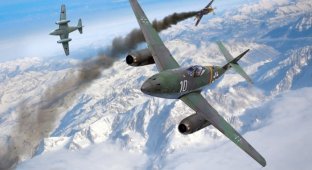A flying submarine is an aircraft that combines the ability of a seaplane to take off and land on water and the ability of a submarine to move underwater.
If you have ever watched or are going to watch the movie "The First Avenger", then you will be able to see just such a plane-submarine at the beginning of the film.

Soviet project
In the USSR, on the eve of the Second World War, a project for a flying submarine was proposed - a project that was never realized. From 1934 to 1938 The flying submarine project (abbreviated: LPL) was led by Boris Ushakov. The LPL was a three-engine, two-float seaplane equipped with a periscope. Even while studying at the Higher Marine Engineering Institute named after F. E. Dzerzhinsky in Leningrad (now the Naval Engineering Institute), from 1934 until his graduation in 1937, student Boris Ushakov worked on a project in which the capabilities of a seaplane were supplemented capabilities of the submarine. The invention was based on a seaplane capable of diving under water.

In 1934, a cadet at VMIU named after. Dzerzhinsky B.P. Ushakov presented a schematic design of a flying submarine (LPL), which was subsequently redesigned and presented in several versions to determine the stability and loads on the structural elements of the device.
In April 1936, a review by Captain 1st Rank Surin indicated that Ushakov’s idea was interesting and deserved unconditional implementation. A few months later, in July, the semi-draft design of the LPL was considered by the Scientific Research Military Committee (NIVK) and received a generally positive review, containing three additional points, one of which read: “... It is advisable to continue the development of the project in order to identify the reality of its implementation by carrying out the corresponding calculations and the necessary laboratory tests...” Among those who signed the document were the head of the NIVK, military engineer 1st rank Grigaitis, and the head of the department of combat tactics, flagship 2nd rank Professor Goncharov.
In 1937, the topic was included in the plan of department “B” of the NIVK, but after its revision, which was very typical for that time, it was abandoned. All further development was carried out by the engineer of department “B”, military technician 1st rank B.P. Ushakov, during off-duty hours.
On January 10, 1938, in the 2nd department of the NIVK, a review of the sketches and main tactical and technical elements of the LPL prepared by the author took place. What was the project? The flying submarine was intended to destroy enemy ships on the open sea and in the waters of naval bases protected by minefields and booms. The low underwater speed and limited cruising range underwater of the LPL were not an obstacle, since in the absence of targets in a given square (area of operation), the boat could find the enemy on its own. Having determined its course from the air, it sat below the horizon, which excluded the possibility of its premature detection, and sank along the ship’s path. Until the target appeared at the salvo point, the LPL remained at depth in a stabilized position, without wasting energy by unnecessary moves.
If the enemy deviated within an acceptable range from the course line, the LPL approached him, and if the target deviated too much, the boat let it go beyond the horizon, then surfaced, took off, and prepared to attack again.

A possible repeat approach to a target was considered one of the significant advantages of an underwater torpedo bomber over traditional submarines. The action of flying submarines in a group should have been especially effective, since theoretically three such devices would create an impenetrable barrier up to nine miles wide in the enemy’s path. The LPL could penetrate enemy harbors and ports at night, dive, and during the day conduct surveillance, find direction of secret fairways, and attack when the opportunity presented itself. The design of the LPL provided for six autonomous compartments, three of which housed AM-34 aircraft engines with a power of 1000 hp each. every. They were equipped with superchargers that allowed boosting up to 1200 hp during takeoff. The fourth compartment was residential, designed for a team of three people. From it the ship was controlled under water. The fifth compartment contained a battery, and the sixth compartment contained a 10 hp electric propulsion motor. The durable body of the LPL was a cylindrical riveted structure with a diameter of 1.4 m made of 6 mm thick duralumin. In addition to durable compartments, the boat had a lightweight wet-type pilot's cabin, which was filled with water when submerged, while the flight instruments were sealed in a special shaft.
The skin of the wings and tail was supposed to be made of steel, and the floats of duralumin. These structural elements were not designed for increased external pressure, since during immersion they were flooded with sea water that flowed by gravity through scuppers (holes for water drainage). Fuel (gasoline) and oil were stored in special rubber tanks located in the center section. During the dive, the inlet and outlet lines of the water cooling system of the aircraft engines were blocked, which prevented their damage under the influence of seawater pressure. To protect the hull from corrosion, the hull was painted and varnished. Torpedoes were placed under the wing consoles on special holders. The boat's design payload was 44.5% of the vehicle's total flight weight, which was typical for heavy-duty vehicles.
The diving process included four stages: battening down the engine compartments, shutting off the water in the radiators, transferring the controls to underwater, and moving the crew from the cockpit to the living compartment (central control station).”
The submerged motors were covered with metal shields. The LPL was supposed to have 6 sealed compartments in the fuselage and wings. Mikulin AM-34 motors of 1000 hp each were installed in three compartments that were sealed during immersion. With. each (with a turbocharger in takeoff mode up to 1200 hp); the sealed cabin had to contain instruments, a battery and an electric motor. The remaining compartments should be used as tanks filled with ballast water for immersing LPLs. Preparing for the dive should only take a couple of minutes.

The fuselage was supposed to be an all-metal duralumin cylinder with a diameter of 1.4 m and a wall thickness of 6 mm. The pilot's cabin filled with water during the dive. Therefore, all devices were supposed to be installed in a waterproof compartment. The crew had to move to the diving control compartment, located further in the fuselage. The supporting planes and flaps must be made of steel, and the floats must be made of duralumin. These elements were supposed to be filled with water through the valves provided for this in order to equalize the pressure on the wings during diving. Flexible fuel and lubricant tanks must be located in the fuselage. For corrosion protection, the entire aircraft had to be covered with special varnishes and paints. Two 18-inch torpedoes were suspended under the fuselage. The planned combat load was supposed to be 44.5% of the total weight of the aircraft. This is a typical value for heavy aircraft of that time. To fill the tanks with water, the same electric motor was used to ensure movement under water.


In 1938, the research military committee of the Red Army decided to curtail work on the Flying Submarine project due to the insufficient mobility of the submarine underwater. The decree stated that after the LPL was discovered by the ship, the latter would undoubtedly change course. This will reduce the combat value of the LPL and will most likely lead to mission failure.
It should be noted that this was not the only domestic project of a flying submarine. At the same time, in the thirties of the last century, I.V. Chetverikov presented a project for a two-seat flying submarine SPL-1 - “an aircraft for submarines.” To be more precise, it was a seaplane that was stored disassembled on a submarine, and upon surfacing it could be easily assembled. This project was a kind of flying boat, the wings of which folded along the sides. The power plant leaned back, and the floats located under the wings were pressed against the fuselage. The tail “empennage” was also partially folded. The dimensions of the SPL-1 when folded were minimal - 7.5 x 2.1 x 2.4 m. Disassembling the aircraft took only 3 - 4 minutes, and preparing it for flight took no more than five minutes. The aircraft storage container was a pipe with a diameter of 2.5 and a length of 7.5 meters.

It is noteworthy that the building materials for such a boat-plane were wood and plywood with fabric covering of the wing and “tail”, while the weight of the empty plane was reduced to 590 kg. Despite this seemingly unreliable design, during testing pilot A.V. Krzhizhevsky managed to reach a speed of 186 km/h on the SPL-1. And two years later, on September 21, 1937, he set three international records in the class of light seaplanes with this machine: speed at a distance of 100 km - 170.2 km/h, range - 480 km and flight altitude - 5,400 m.
In 1936, the SPL-1 aircraft was successfully demonstrated at the International Aviation Exhibition in Milan.
And this project, unfortunately, never entered mass production.
German project
In 1939, large submarines were planned for construction in Germany, and it was then that the project of the so-called “Eyes of the Submarine” was presented, a small float aircraft that could be assembled and folded in the shortest possible time and located in a limited space. At the beginning of 1940, the Germans began producing six prototypes under the designation Ar.231.

The devices were equipped with 6-cylinder air-cooled Hirt NM 501 engines and had a lightweight metal structure. To facilitate folding of the wings, a small section of the center section was mounted above the fuselage on struts at an angle so that the right console was lower than the left, allowing the wings to be folded one above the other when turning around the rear spar. The two floats were easily detached. When disassembled, the aircraft fit into a pipe with a diameter of 2 meters. It was assumed that the Ar.231 was to be lowered and raised aboard the submarine using a folding crane. The process of disassembling the aircraft and storing it in the tubular hangar took six minutes. Assembly took about the same amount of time. For a four-hour flight, a significant supply of fuel was placed on board, which expanded the possibilities when searching for a target.
The first two Ar.231 devices V1 and V2 saw the sky at the beginning of 1941, but they were not successful. The flight characteristics and behavior of the small aircraft on the water turned out to be inadequate. In addition, the Ar.231 could not take off at wind speeds of more than 20 knots. In addition, the prospect of being on the surface for 10 minutes while assembling and disassembling the aircraft did not sit well with submarine commanders. In the meantime, the idea arose to provide aerial reconnaissance using the Focke-Angelis Fa-330 gyroplane, and although all six Ar.231s were completed, the aircraft did not receive further development.

The Fa-330 was a simple design with a three-blade propeller without a mechanical engine. Before the flight, the propeller was untwisted using a special cable, and then the gyroplane was towed by a boat on a 150-meter-long leash.
Essentially, the Fa-330 was a large kite that flew at the expense of the speed of the submarine itself. Telephone communication with the pilot was carried out through the same cable. With a flight altitude of 120 meters, the viewing radius was 40 kilometers, five times greater than from the boat itself.

The disadvantage of the design was the long and dangerous procedure for landing the gyroplane on the deck of the boat. If she needed an urgent dive, she had to abandon the pilot along with his helpless unit. As a last resort, the reconnaissance officer relied on a parachute.
Already at the end of the war, in 1944, the Fa-330, which was not very popular among German submariners, was upgraded to the Fa-336, adding a 60-horsepower engine and turning it into a full-fledged helicopter. This innovation, however, did not have much impact on Germany’s military successes.
American RFS-1 or LPL Reida
The RFS-1 was designed by Donald Reid using parts from planes that had crashed. A serious attempt to make an aircraft capable of serving as a submarine, Reid's project came to him almost by accident when a set of model airplane wings fell off the skin and landed on the fuselage of one of his radio-controlled submarines, which he had been developing since 1954. Then the idea was born to build the world's first flying submarine.
First, Reid tested models of different sizes of flying submarines, then tried to build a manned vehicle. As an aircraft it was registered N1740 and was equipped with a 4-cylinder 65 hp engine. In 1965, the RFS-1 made its first flight, piloted by Don's son, Bruce, and flew over 23 m. The pilot's seat was initially in the engine pylon, then moved to the fuselage before the first flight.

In order to convert an airplane into a submarine, the pilot had to remove the propeller and cover the engine with a rubber “diving bell.” At auxiliary power, small 1 hp. the electric motor was located in the tail, the boat moved underwater, the pilot used scuba gear at a depth of 3.5 m.
Underpowered, Reid's RFS-1, also known as the Flying Submarine, actually flew, briefly, but it still managed to maintain flight and was capable of submersion. Don Reid tried to interest the military in this device, but to no avail. He died at the age of 79 in 1991.

Japan has gone the furthest
Japan also could not ignore such an exciting idea. There, airplanes became almost the main weapon of submarines. The vehicle itself turned from a reconnaissance aircraft into a full-fledged attack aircraft.
The appearance of such an aircraft for a submarine as the Seyran (Mountain Fog) turned out to be an extraordinary event. It was actually an element of a strategic weapon that included a bomber aircraft and a submersible aircraft carrier. The aircraft was designed to bomb targets in the United States of America that no conventional bomber could reach. The main bet was made on complete surprise.

The idea of a submarine aircraft carrier was born in the minds of the Imperial Japanese Naval Headquarters a few months after the outbreak of the Pacific War. It was intended to build submarines that were superior to anything previously created specifically for transporting and launching attack aircraft. A flotilla of such submarines would cross the Pacific Ocean, launch their aircraft directly in front of the chosen target, and then dive. After the attack, the planes had to go out to meet the underwater aircraft carriers, and then, depending on the weather conditions, the method of rescuing the crews was chosen. After this, the flotilla plunged under water again. For a greater psychological effect, which was placed above physical damage, the method of delivering the aircraft to the target should not have been disclosed.
Next, the submarines had to either go out to meet the supply ships to receive new aircraft, bombs and fuel, or act in the usual way, using torpedo weapons.
The program, naturally, developed in an atmosphere of heightened secrecy and it is not surprising that the Allies first heard about it only after the surrender of Japan. At the beginning of 1942, the Japanese High Command issued an order to shipbuilders for the largest submarines built by anyone until the beginning of the atomic age in shipbuilding. It was planned to build 18 submarines. During the design process, the displacement of such a submarine increased from 4125 to 4738 tons, and the number of aircraft on board from three to four.
Now it was up to the plane. The fleet headquarters discussed the issue with the Aichi concern, which, starting in the 20s, built aircraft exclusively for the fleet. The Navy believed that the success of the whole idea depended entirely on the high performance of the aircraft. The aircraft had to combine high speed to avoid interception with a long flight range (1500 km). But since the aircraft was intended for virtually one-time use, the type of landing gear was not even specified. The diameter of the underwater aircraft carrier's hangar was set at 3.5 m, but the fleet required that the aircraft fit in it without disassembly - the planes could only be folded.
Aichi designers, led by Tokuichiro Goake, considered such high demands a challenge to their talent and accepted them without objection. As a result, on May 15, 1942, the 17-C requirements for an experimental bomber for special missions appeared. The chief designer of the aircraft was Norio Ozaki.

The development of the aircraft, which received the corporate designation AM-24 and the short M6A1, proceeded surprisingly smoothly. The aircraft was created for the Atsuta engine, a licensed version of the 12-cylinder liquid-cooled Daimler-Benz DB 601 engine. From the very beginning, the use of detachable floats was envisaged for the only dismantled part of Seiran. Since the floats significantly reduced the aircraft's flight performance, provisions were made for releasing them in the air if such a need arose. In the submarine hangar, mounts for two floats were accordingly provided.
In the summer of 1942, a wooden model was ready, on which the folding of the wings and tail of the aircraft was mainly practiced. The wings were hydraulically rotated with the leading edge down and folded back along the fuselage. The stabilizer was manually folded down and the fin to the right. To operate at night, all folding units were coated with a luminous compound. As a result, the overall width of the aircraft was reduced to 2.46 m, and the height on the ejection trolley to 2.1 m. Since the oil in the aircraft systems could be heated while the submarine was under water, the aircraft could ideally be launched without landing gear from the catapult already 4.5 minutes after ascent. It took 2.5 minutes to attach the floats. All preparations for takeoff could only be carried out by four people.
The aircraft's structure was all-metal, with the exception of plywood covering the wing tips and fabric covering of the control surfaces. Double-slotted all-metal flaps could be used as air brakes. The crew of two people was located under a single canopy. In January 1943, it was decided to install a 13 mm Type 2 machine gun in the rear of the cabin. Offensive armament consisted of an 850 kg torpedo or one 800 kg or two 250 kg bombs.
At the beginning of 1943, six M6A1s were laid down at the Aichi plant in Nagoya, two of which were made in the training version M6A1-K on a wheeled chassis (the aircraft was called Nanzan (South Mountain)). The aircraft, with the exception of the fin tip, was almost no different from the main version, and even retained the attachment points to the catapult.
At the same time, in January 1943, the keel of the first submarine aircraft carrier I-400 was laid. Soon two more submarines I-401 and I-402 were laid down. Production of two more I-404 and I-405 was being prepared. At the same time, it was decided to build ten submarine aircraft carriers smaller than two Seirans. Their displacement was 3300 tons. The first of them, I-13, was laid down in February 1943 (according to the original plan, these boats were supposed to have only one reconnaissance aircraft on board).

At the end of October 1943, the first experimental Seyran was ready, flying the following month. In February 1944, the second aircraft was ready. The Seiran was a very elegant seaplane, with clean aerodynamic lines. Externally, it was very similar to the D4Y deck dive bomber. Initially, the D4Y was indeed considered as a prototype for a new aircraft, but at the beginning of the design work this option was rejected. The unavailability of the AE1P Atsuta-32 engine determined the installation of the 1400-horsepower Atsuta-21. The test results have not been preserved, but they were apparently successful, since preparations for mass production soon began.
The first production M6A1 Seyran was ready in October 1944, seven more were ready by December 7, when an earthquake seriously damaged equipment and stocks at the plant. Production was almost restored when an American air raid on the Nagoya area followed on March 12. Soon it was decided to stop serial production of Seyran. This was directly related to the problems of building such large submarines. Although I-400 was ready on December 30, 1944, and I-401 a week later, it was decided to convert I-402 into an underwater transport, and production of I-404 was stopped in March 1945 at 90% completion. At the same time, production of AM type submarines was stopped and only I-13 and I-14 were brought to readiness. The small number of submarine aircraft carriers has consequently limited the production of submarine aircraft. Instead of the initial plans to produce 44 Seirans, only 14 were produced by the end of March 1945. Six Seirans were still produced before the end of the war, although many vehicles were at various stages of readiness.
At the end of autumn 1944, the Imperial Navy began training Seiran pilots, and flight and maintenance personnel were carefully selected. On December 15, the 631st Air Corps was created under the command of Captain Totsunoke Ariizumi. The corps was part of the 1st submarine flotilla, which consisted of only two submarines I-400 and I-401. The flotilla consisted of 10 Seirans. In May, submarines I-13 and I-14 joined the flotilla and were involved in the training of Seyran crews. During six weeks of training, the time to release three Seyrans from a submarine was reduced to 30 minutes, including the installation of floats, although in combat it was planned to launch aircraft without floats from a catapult, which required 14.5 minutes.
The initial target of the 1st flotilla was the locks of the Panama Canal. Six aircraft were to carry torpedoes and the remaining four bombs. Two aircraft were assigned to attack each target. The flotilla was to take the same route as Nagumo's squadron during the attack on Pearl Harbor three and a half years earlier. But it soon became clear that even if successful, such a raid was absolutely pointless in influencing the strategic situation in the war. As a result, on June 25, an order was issued to send the 1st Submarine Flotilla to attack American aircraft carriers at Ulithi Atoll. On August 6, I-400 and I-401 left Ominato, but soon a fire broke out on the flagship due to a short circuit. This forced the start of the operation to be postponed until August 17, two days before which Japan surrendered. But even after this, Japanese naval headquarters planned to attack on August 25th. However, on August 16, the flotilla received orders to return to Japan, and four days later to destroy all offensive weapons. On I-401, planes were ejected without starting engines and without crews, and on I-400 they were simply pushed into the water. Thus ended the story of the most unusual scheme for the use of naval aviation during the Second World War, interrupting the history of underwater aircraft for many years.

Tactical and technical characteristics of the M6A Seyran:
Type: two-seat submarine bomber
Engine: Atsuta 21, 12-cylinder liquid cooled, takeoff power 1400 hp, 1290 hp at an altitude of 5000 m
Weapons:
1 * 13 mm machine gun Type 2
1*850 kg torpedo, or 1*800 kg bomb, or 2*250 kg bombs
Maximum speed:
430 km/h at the ground
475 km/h at an altitude of 5200 m
Cruising speed - 300 km/h
Time to rise to altitude:
3000 m - 5.8 min
5000 m - 8.15 min
Ceiling - 9900 m
Flight range - 1200 km at a speed of 300 km/h and an altitude of 4000 m
Weight:
empty - 3300 kg
takeoff - 4040 kg
maximum - 4445 kg
Dimensions:
wingspan - 12.262 m
length - 11.64 m
height - 4.58 m
wing area - 27 sq.m

Our days
The United States is currently working on the Cormorant aircraft.
American engineer L. Rayle created the Cormorant project - a silent jet unmanned aerial vehicle based on a submarine, which can be equipped with both a melee weapon system and reconnaissance equipment.

Skunk Works, owned by Lockheed Martin, is developing an unmanned aircraft that will be launched from a submarine from an underwater position. Skunk Works is famous for developing the U-2 Dragon Lady and SR-71 Black Bird reconnaissance aircraft in the 1960s.
The new development is called Cormorant (cormorant). The aircraft will be able to launch from the Trident ballistic missile silo of Ohio-class submarines. These strategic missile carriers ceased to be in demand with the end of the Cold War, and now some of them are being converted into special operations submarines.
The aircraft will be launched using a manipulator, which will bring it to the surface. After this, the drone will open its folded wings and be able to fly. It will land on the water, after which the same manipulator will return the aircraft aboard the submarine.

However, creating an aircraft that can withstand pressure at a depth of 150 feet, and at the same time light enough to fly, is not an easy task. Another difficulty is that submarines survive due to their silence, and a plane returning back to the boat can give away its location. Skunk Works' answer: a four-ton plane with gull wings that can fold along the plane's body so it can fit into a silo.
The design of the aircraft is durable - the body, made of titanium, is designed to withstand overloads that can occur at a depth of 45 meters, and all voids are filled with foam, which increases strength. The rest of the body is compressed by inert gas. Inflatable rubber seals protect weapon bays, engine inlets and other aircraft parts. The geometry of the hull is made according to a complex design, which reduces its radio signature. The aircraft will be capable of performing reconnaissance or strike missions, depending on the equipment with which it will be equipped.

Thanks to the resource for the materials provided: feldgrau.info






















